Do you have a neighbor who is exceptionally on your nerves? His wealth stings your eyes? Get rid of him! This was the assumption made by Abraham Skowieski, a 16th-century tenant of a village in Podlasie. How did he manage to fix the "problem"?
Skowieski was at odds with the local Jews, so he decided to get rid of the problem once and for all. The origin of his disliked neighbors only made things easier for him. The nobleman used the death of a little boy to accuse them of ritual murder.
Four-year-old Wojciech Petrenia disappeared on March 25, 1598 on the first Wednesday after Easter. That day, he went with his father, a miller in the village of Świniarów near Łosice, to work in the fields. Busy plowing, Maciej Petrenia did not observe what his son was doing at that time. When he finished the job, he saw that the child had fallen into the ground. The search, which was started immediately, yielded nothing.
(Un) medical diagnosis
A few weeks later, the local boys, while looking for duck eggs on the bank of the Toczek River, found human remains lying in the reeds. They ran to the village and reported the discovery. It was the massacred corpse of a small child . They were taken to the nearby Woźniki, to the manor house belonging to the Polish nobleman Abraham Skowieski, the tenant of the estate.
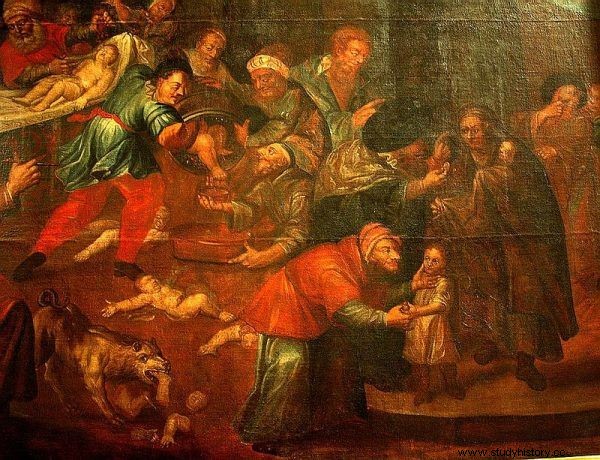
Karol de Prevot made Jews pouring the blood of a baby placed in a barrel full of nails into the center of his painting. Below is a quartered other child whose unnecessary limbs are fed to the dog. This is called anti-Semitic propaganda. The painting was placed in the cathedral in Sandomierz.
Maciej Petrenia was immediately sent for, and the miller, having barely looked at the body, recognized his missing son. The child had numerous stab wounds, cuts and lacerations, including those on the wrists and elbows. They could be asked by both a man and an animal:a large dog, a wolf, a lynx. Four centuries ago, the level of medical knowledge did not allow for a quick and accurate determination of the cause of death. If at all it was possible, in addition - in the case of a cadaver in a progressive state of decomposition.
However, Skowieski, although he was not a doctor, issued the "diagnosis" right away. In an overbearing tone, he stated that Wojciech Petrenia was murdered by Jews who needed the blood of a Christian child to bake traditional matzah (you can read about the most absurd accusations against Jews in our other article).
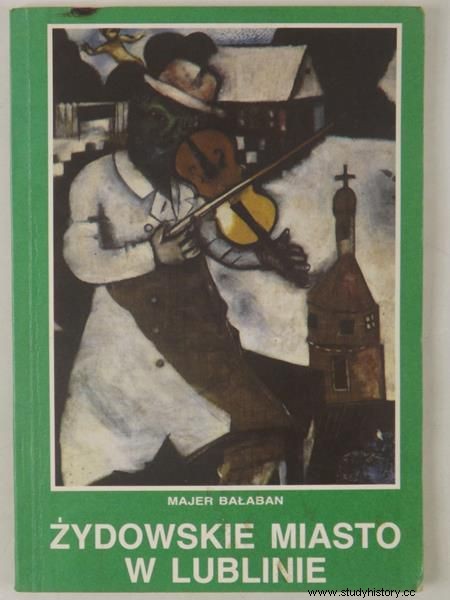
One of the inspirations for writing the article was the work by Majer Bałaban "Jewish city in Lublin" (Lublin 1991).
At least I'll get out of debt
Abraham Skowieski was a bitter man. The estate he managed brought considerable income, but the majority of the profits went to the owner of Woźniki and Świniarów, Anna Kiszczanka, voivode of Podlasie, wife of Istvan Pety, Hungarian noble with the title of baron.
The Polish nobleman, however, did not dare to ask for money from his employer. However, he found himself guilty of his own "wrong". He didn't have to look far. There was an inn near the manor house, the leaseholder of which was a Jew, Marek Sachowicz. The business prospered brilliantly, which undoubtedly inspired Skowieski's anger and envy. But there was nothing he could do. In the Polish-Lithuanian Commonwealth, most of the country taverns belonged to landowners, and innkeepers (who were most often recruited from people of Jewish origin) - if they lived well with their masters - were "unmovable" by peasants or "grays".
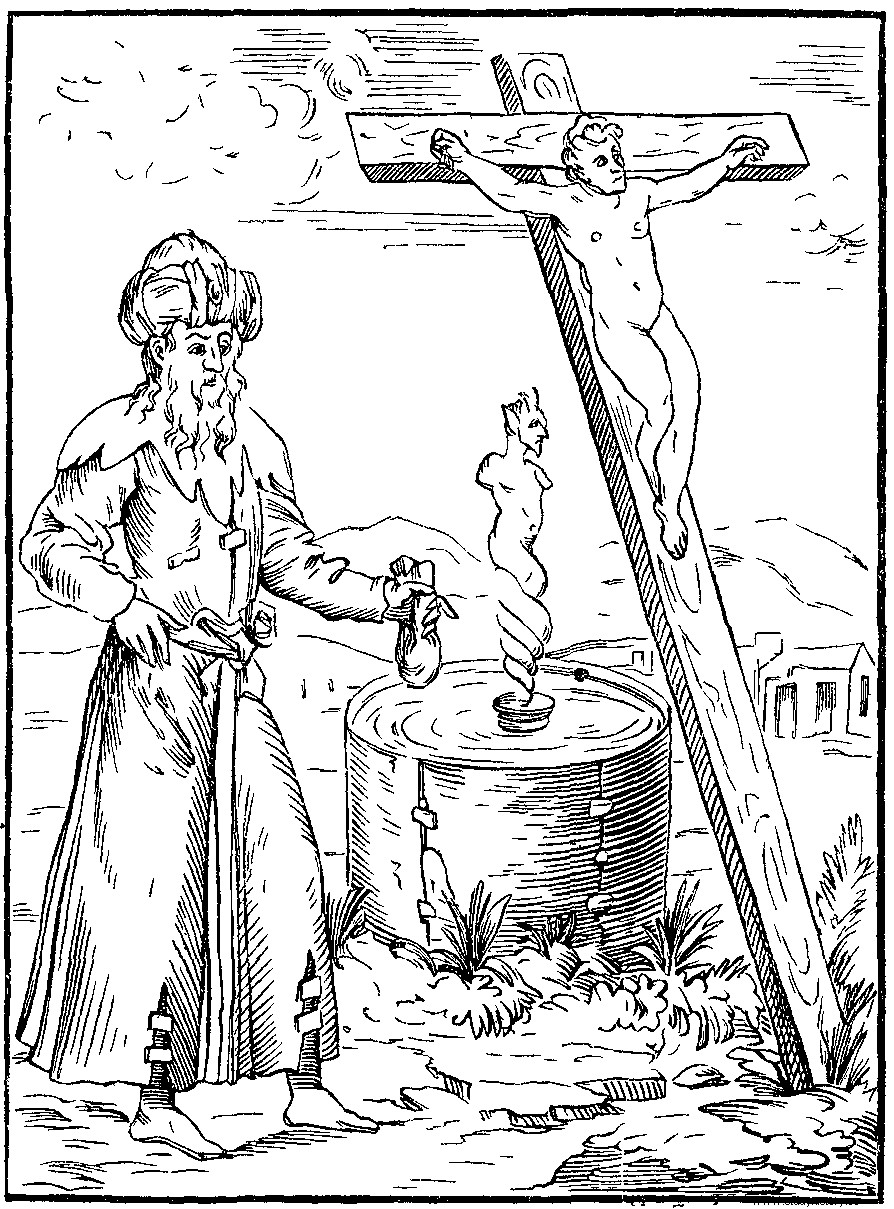
In the 16th century, rumors about Jews were believed not only in Poland. Pictured is a Jew calling the Devil from a blood vessel filled with the blood of murdered Christian children ("Historied Prodigieuses" 1560).
It would be different if a given Jewish innkeeper was charged with a crime or other serious crime. Nobody would stand up for the murderer. Apparently, Skowieski hastily persuaded the miller Petrenia to agree to the accusation of the murder of his son in the town of Mielnik and indicated Sachowicz's family as suspects. The father of the murdered man quickly agreed to this offer, especially since he owed the innkeeper 100 zlotys. It is possible that Skowieski convinced him that if he accused a Jew, he would not have to pay him back. .
Soon, on the charge of ritual murder, Marek Sachowicz, his son Gromek (Aaron) and son-in-law Izaak Eisig were thrown into the dungeons of the prison at the Mielnica castle. Later they were joined by the innkeeper's wife and their attendant Joachim.
Torture works for everything
The defendants were tried in the Crown Tribunal in Lublin. Since they claimed they were innocent, their resistance had to be smashed in some way. This was taken care of by the executioner, who in a moment of inspiration poured vodka over their heads and then set them on fire . No wonder that the Jews who were brought to trial soon pleaded guilty.
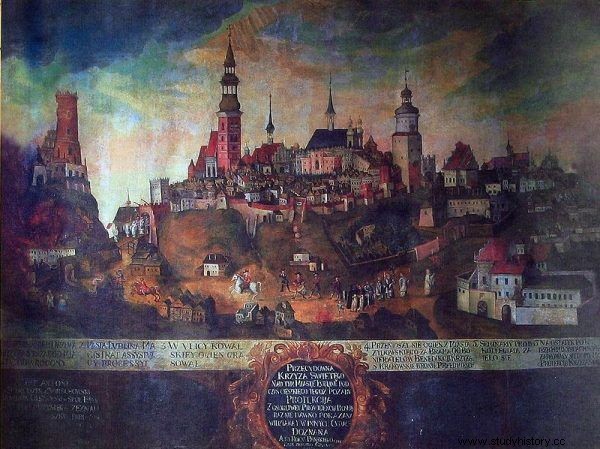
The building of the Crown Tribunal in Lublin in the 18th century painting "Fire of the City of Lublin". It was here that the most famous trials of alleged Jewish crimes in the Polish-Lithuanian Commonwealth took place.
Joachim testified that he saw a bucket full of blood in the Sachowicz's chamber, and the landlady secretly told him that it was the blood of a "Christian child". Forced by their torments, Gromek and Eizig admitted that they had kidnapped Wojciech Petrenia on the orders of Zelman, the elder of the Jewish community in Międzyrzec Podlaski, and then placed an inn in the basement, where the boy had been imprisoned for some time. The child was murdered with knives by Zelman and a certain Moszko. They shed blood from the body, which they shared between themselves and the Sachowicz family. When asked who took the body out, Gromek and Eisig replied that it was done - in exchange for a kick of eggs - by a young Christian maid, Nastka.
The accusation of murder without evidence of guilt, based solely on testimony forced by torture, aroused protests from the Lublin Jewish community, townspeople, and also some progressive clergy. Therefore, the court decided to obtain incriminating evidence without resorting to the services of the executioner. Nastka was ordered to be brought from Woźniki and questioned.
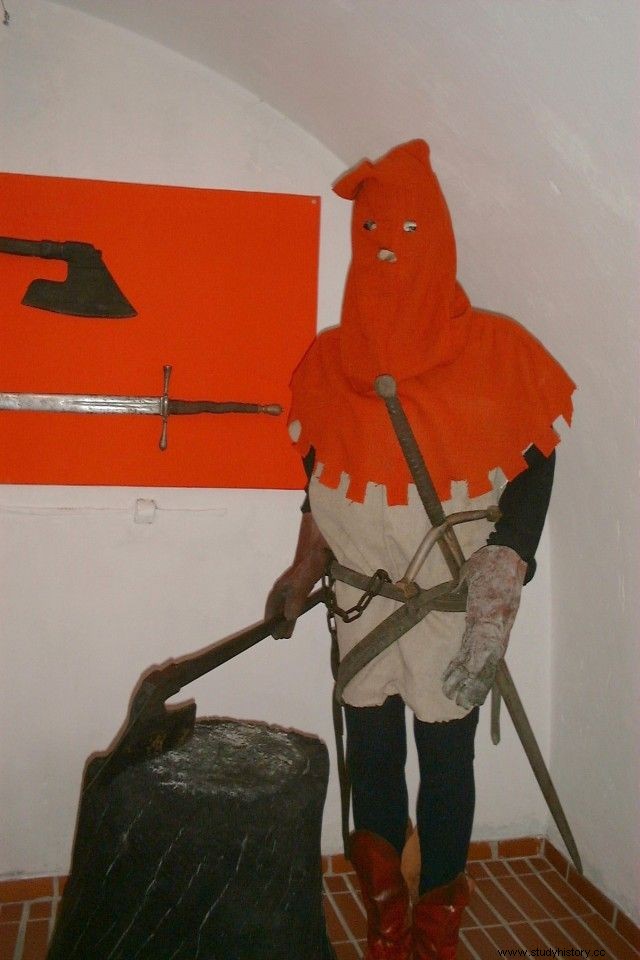
Don't you know how to make someone admit to you guilt they didn't commit? Torture him. This was the assumption made by Polish judges of the Polish-Lithuanian Commonwealth. The photo shows the figure of an executioner in the torture museum in Żywiec.
Luck wanted (or maybe it was not a coincidence at all) that canon Treter from Poznań met her at the city gates, who was keenly interested in the trial. He ordered the wagon in which she was traveling to be stopped, and then in a face-to-face conversation he reminded her of her duties towards the Christian faith. He convinced her that if she would help reveal "the truth," it would be her great personal merit to God. Treter's persuasion power must have been enormous because the girl confirmed the testimony against the Jews.
And that was enough. Interestingly, Zelman and Moszko, the alleged direct perpetrators of the murder, were not brought to trial. Apparently they escaped. Apparently, those who had no chance of escape were satisfied. The judgment of the Tribunal was issued on July 11, 1598. Marek and Gromek (Aaron) Sachowicz, Izaak Eisig and the wife of the lessee from Woźniki were sentenced to death by dismemberment alive . Joachim's attendant was acquitted. He was baptized soon.
Gromek (Aaron), while still in prison, hanged himself on the loop he made from his pants. Marek Sachowicz was taken outside the city and dismembered. His wife and son-in-law were executed in the same way.

Bernard Maciejowski was bishop of Lutsk and Kraków, then archbishop of Gniezno and Polish primate. He acquired priestly dignities persistently, pursuing a skillful policy. One of his best moves was to support the efforts for the Polish throne of Sigismund III Vasa.
Diplomatic Vatican
The death of a child as a result of an alleged ritual murder, the Catholic Church also tried to use for its own purposes. The village of Świniarów was located in the Łuck diocese, whose bishop was Bernard Maciejowski. At the behest of His Excellency, the boy's body was buried in a small church in the village of Litewniki.
Four years later, the burial place was changed. Maciejowski had great ambitions and was climbing the ranks of the church career at a fast pace. In 1600 he was nominated the bishop of Krakow, but he aimed much higher. Perhaps he decided that the alleged victim of a Jewish ritual murder would help him on his way to the top. He ordered the child's body to be transferred to the church of Fr. Jesuits in Lublin, who then had its seat in the present Cathedral.
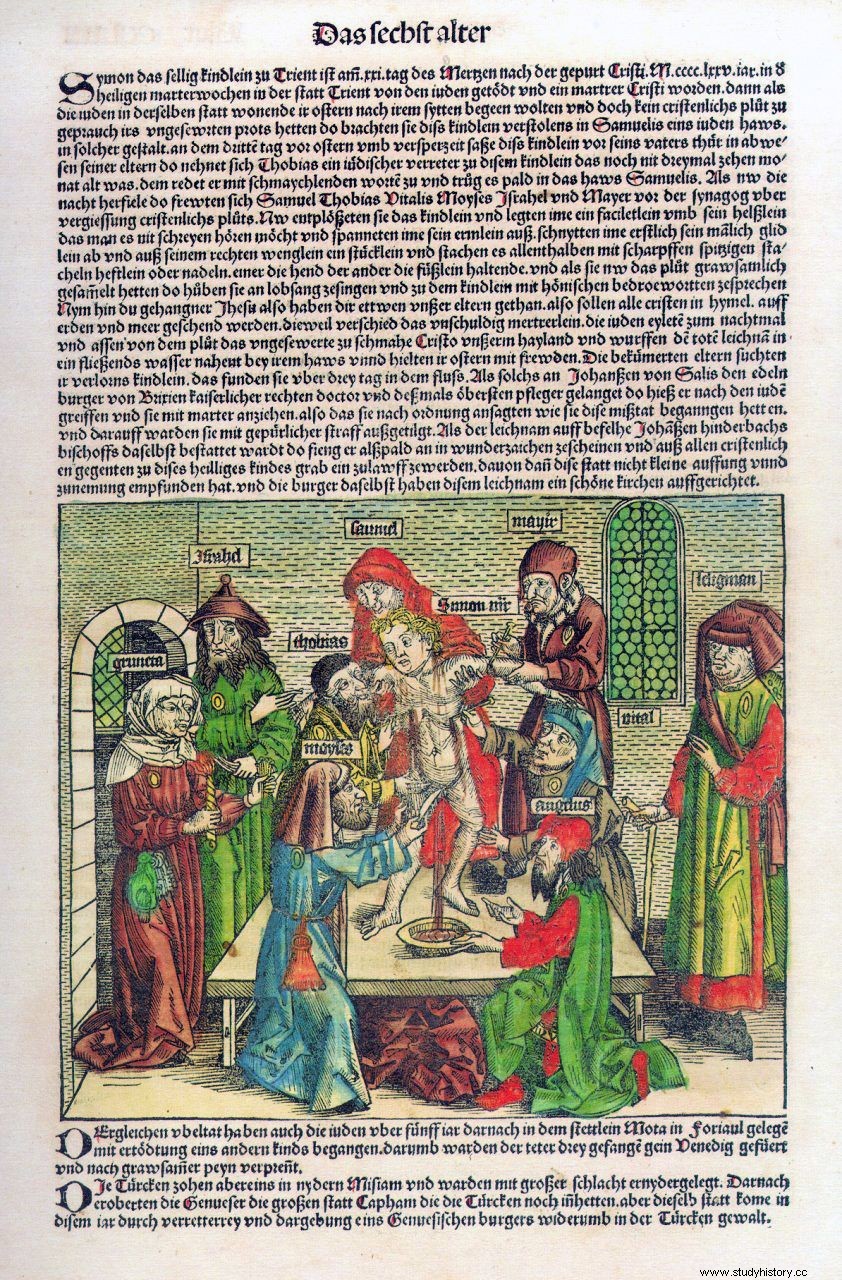
No wonder Bishop Maciejowski wanted to create a cult of young Petrenia. In the end, Simon, who was said to have been murdered by the Jews, was successfully made blessed by the Catholic Church. The illustration shows the alleged ritual murder committed by Jews on Simon of Trento in 1475 (Weltrchronik by Hartmann Schedel, 1493)
The tin coffin with the remains was placed on the main altar. Soon people's pilgrimages began to take place there . The Jesuits gave the event sufficient publicity. Attempts were made to create a cult of a martyred Christian child.
A few years later, Bishop Maciejowski, who was applying for the title of cardinal, went to Rome to start preparations for the canonization process of Wojciech Petrenia. But he didn't do anything. At the same time, the Jewish community demanded the rehabilitation of those sentenced in the Lublin trial. The case was even discussed by a royal commission appointed by Sigismund III Vasa. However, nothing was ultimately established. Perhaps the Vatican decided that it would act diplomatically by not supporting either side? Or simply:he washed his hands.
